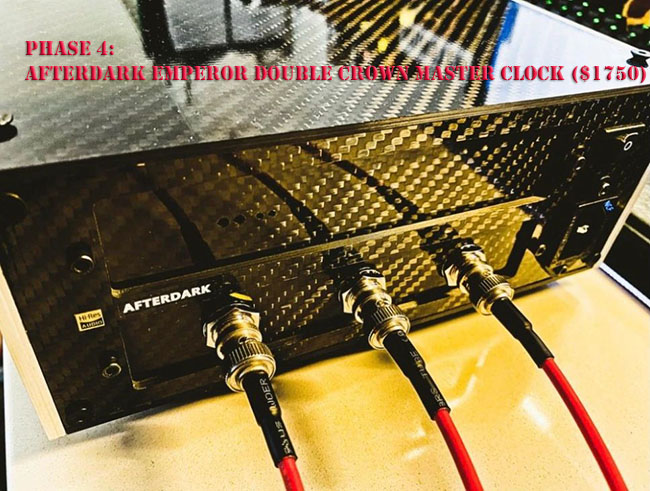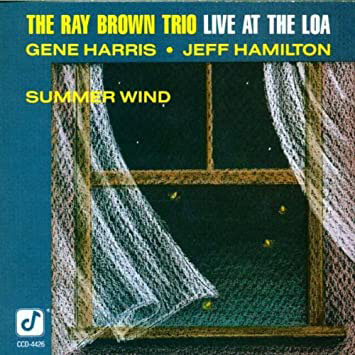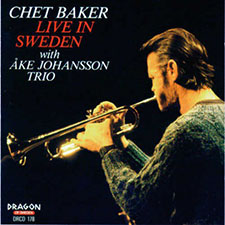NETWORK PROJECT. THE ANATOMY OF A NETWORK SYSTEM page 2

Page 2

 But, there’s more. My conversations with Frank Smith of Citronic Music revealed another topology that he insisted I should consider. I became skeptical because the sonics I was now getting was significantly ahead of what I had before upgrading to wired. Frank was adamant about the AfterDark MasterClocks. I also recall Mr. Arora mentioning this topology in his review. The EtheRegen was priced reasonably for audiophile equipment; however, the AfterDark MasterClock was exceptionally and affordably priced, depending on which you select. I ordered the middle-of-the-line AfterDark MasterClock and Power Supply that Mike Girardi writes about in his excellent review. After less than two weeks, I received both items, and I cannot begin to tell you how amazed I was with the additions. Let me tell you, my friends, whenever you have the opportunity to move up another level, I say take it, especially in the audio arena. I could not have dreamed that after the addition of the EtherRegen and going completely wired, I would experience this type of beautiful sonics. Six months ago, I had no idea of the potential of network streaming. I eventually upgraded to the AfterDark top-of-the-line Emperor Geisman EVA Master Clock (A review worth writing separately).
But, there’s more. My conversations with Frank Smith of Citronic Music revealed another topology that he insisted I should consider. I became skeptical because the sonics I was now getting was significantly ahead of what I had before upgrading to wired. Frank was adamant about the AfterDark MasterClocks. I also recall Mr. Arora mentioning this topology in his review. The EtheRegen was priced reasonably for audiophile equipment; however, the AfterDark MasterClock was exceptionally and affordably priced, depending on which you select. I ordered the middle-of-the-line AfterDark MasterClock and Power Supply that Mike Girardi writes about in his excellent review. After less than two weeks, I received both items, and I cannot begin to tell you how amazed I was with the additions. Let me tell you, my friends, whenever you have the opportunity to move up another level, I say take it, especially in the audio arena. I could not have dreamed that after the addition of the EtherRegen and going completely wired, I would experience this type of beautiful sonics. Six months ago, I had no idea of the potential of network streaming. I eventually upgraded to the AfterDark top-of-the-line Emperor Geisman EVA Master Clock (A review worth writing separately).

The next and last phase was challenging for me to accept. I mention this because I was ecstatic about what I had accomplished up to now. Sometimes, we, as audiophiles, always try to stretch the limit a bit too far. We can obtain a sound that is way above what we had months before. I, for one, am guilty of this, and the old bug was back nipping at my curiosity again. What Happened?… As I was researching and shopping for an LPS to purchase during Phase 3. As I read numerous reviews and articles on different Power Supplies, I came across a review on a Sean Jacobs DC3 Power Supply; the review was intriguing; however, when I saw the $7300 price tag, I immediately turned the page. But my curiosity got the best of me, so I visited the forums to read the latest. In most media or conversations I have engaged in the past, I always come across a few naysayers and snake oil comments; however, I could not find one naysayer, or to take it even further, I could not find any negative comments, only praises. Everything written or commented on was how this Sean Jacobs Power Supply is a must-have in any network/music streamer. Ok, come on now, I am experiencing the cream of the crop as my system is currently configured, or am I?.
 Nevertheless, I reached out to the factory requesting a review sample, and much to my delight, I was granted one. After six weeks, I was shipped a brand spanking new upgraded Sean Jacobs DC4 Power Supply built with Mundorf Capacitors. I wasn’t sure how this new addition would fit into a system that I felt was the cream de la crem. What the hell was I thinking? Ok, let me get off this pity train; it’s my job as a reviewer to accept challenges. Some of my concerns addressed were; I had transitioned to an entirely new concept of music source within the past six months, should I have slowed down and let all the previous additions settle in a little longer, did I jump the gun, was I moving too fast? For the answers to these questions, I stayed tuned; Once the Sean Jacobs DC4 Power Supply arrived, I was amazed at the size of the unit; no other LPS I owned came close to its massive size or weight. What the heck is in this thing. Is there nuclear material in this box? Upon arrival, the DC4 was well packed for shipment, and the component build was of the highest quality. I spent a few minutes unpacking the unit and let it sit for a day before connecting to the Roon Nucleus. The DC4 unit shipped was new. I was advised to give it at least two weeks to allow the new capacitors to burn-in, and then I could conduct initial critical listening.
Nevertheless, I reached out to the factory requesting a review sample, and much to my delight, I was granted one. After six weeks, I was shipped a brand spanking new upgraded Sean Jacobs DC4 Power Supply built with Mundorf Capacitors. I wasn’t sure how this new addition would fit into a system that I felt was the cream de la crem. What the hell was I thinking? Ok, let me get off this pity train; it’s my job as a reviewer to accept challenges. Some of my concerns addressed were; I had transitioned to an entirely new concept of music source within the past six months, should I have slowed down and let all the previous additions settle in a little longer, did I jump the gun, was I moving too fast? For the answers to these questions, I stayed tuned; Once the Sean Jacobs DC4 Power Supply arrived, I was amazed at the size of the unit; no other LPS I owned came close to its massive size or weight. What the heck is in this thing. Is there nuclear material in this box? Upon arrival, the DC4 was well packed for shipment, and the component build was of the highest quality. I spent a few minutes unpacking the unit and let it sit for a day before connecting to the Roon Nucleus. The DC4 unit shipped was new. I was advised to give it at least two weeks to allow the new capacitors to burn-in, and then I could conduct initial critical listening.
I was also informed that the DC4 could take as long as six weeks to reach total capacity. I usually get the same spill from other manufacturers. However, that is rarely the case, so why would this unit be any different. After a couple of weeks, I thought I heard an uptick in sonics, but I wasn’t sure. I knew that I had added so much to a new digital source and was still getting used to the blend of new technology. Let’s get real. I’ve just been rewarded the benefits of what streaming at its best sounds, or what I think is best; why? Am I trying to convince myself there is more?
I don’t know if there is a time clock in this unit; however, after four weeks, the Sean Jacobs DC4 began to open up like the red sea. Everything just started sounding more decadent and more open. It seemed like the next two weeks, the already incredible sonics improved more and more each day. All the things I read and heard about the Sean Jacobs Power Supplies became very apparent and accurate. The DC4 took all the attributes of the components in the network chain and made them significantly better. There is no way to tell how much noise is still present in your system until it’s gone. The Sean Jacobs DC4 Power Supply eliminates the network noise; YES, that can be a bold statement; however, until you experience it, then there is no way you can identify what I just claimed. Ever since investing megabucks into my audio system, I have learned over the years that there is no substitute or shame in opting for the best you can afford. I agree that audio can get painfully expensive at times, and yes, there are many bargains out there if you do your homework. But, all in all, in the world of high-end audio, you get what you pay for (That’s just the facts). This goes for exclusively when investing in a Sean Jacobs Power Supply; (Expensive). However, it will suck every note out of your network and allow the music to flow like clean, pure water. Zero restrictions. BTW. The MP64 is now my backup digital source.
Listening Experiences:
 Ray Brown Trio’s Summerwind, from his Live at The LOA recording: In the past, I heard things from that streamed CD played through Tidal that was spooky. I heard Ray Brown’s voice serenading the audience while playing the upright bass. Yes, I have listened to him before Sean Jacobs and all the additional add ons; however, I have never been able to make out what he was saying and so clearly until the addition of the DC4. The notes played on the keyboard by Gene Harris on Little Darlin brought chills accompanied by a new appreciation of what a three-band trio can accomplish. This CD has got to be one of the most excellent live recordings ever captured on musical media.
Ray Brown Trio’s Summerwind, from his Live at The LOA recording: In the past, I heard things from that streamed CD played through Tidal that was spooky. I heard Ray Brown’s voice serenading the audience while playing the upright bass. Yes, I have listened to him before Sean Jacobs and all the additional add ons; however, I have never been able to make out what he was saying and so clearly until the addition of the DC4. The notes played on the keyboard by Gene Harris on Little Darlin brought chills accompanied by a new appreciation of what a three-band trio can accomplish. This CD has got to be one of the most excellent live recordings ever captured on musical media.
Norah Jones (Come Away With Me) took me to a place that I did not know was possible. I am a massive fan of her voice, however with the addition of the assembled network music streaming in its entirety, I felt 100% heard/captured the emotional cues of her voice to the point of hair-raising goosebumps. This woman is blessed with an incredible voice, and she has fantastic GOD-GIVEN talent. I have never appreciated this album as much before the addition of streaming and Tidal. However, I will never be able to say that again, especially since I’ve realized what streamed digital music can do.
Aretha Franklin (Amazing Grace), I cannot find the words to express the brilliance of this recording. This recording can be played on a Hasbro CloseHo and Play and still move me to tears. There was and will never be a voice like that of “The Queen.” When I listen to Aretha’s unique voice on the most excellent gospel album ever produced and streamed through Tidal, coupled with all the upgrades reviewed in this writing, all I can say is, “HAVE MERCY.” If you have not experienced this album, you’re missing out. Perfection is Perfection, no matter how you define it.
 Chet Baker’s “Live in Sweden”!! This CD is over-recorded at best; however, Chet Baker’s singular horn talents make this one of my favorite jazz CDs. Miles Davis will always be my number one; however, Chet Baker’s musical notes on “Lament” are something to behold. The live club setting places me squarely in the venue, and I cannot recall having heard or experienced a more electronic live club atmosphere when paired with my new streaming setup—a must-have.
Chet Baker’s “Live in Sweden”!! This CD is over-recorded at best; however, Chet Baker’s singular horn talents make this one of my favorite jazz CDs. Miles Davis will always be my number one; however, Chet Baker’s musical notes on “Lament” are something to behold. The live club setting places me squarely in the venue, and I cannot recall having heard or experienced a more electronic live club atmosphere when paired with my new streaming setup—a must-have.
Conclusion: When I first ventured on this music streaming journey, I had no idea it would take me this far. I already knew of game and video streaming; however, I never related streaming to high-end audio. Digital is digital ( ones and zeros) and can be manipulated in many different forms and formats. The experiences I have had over the past nine months with music streaming have been one of the more intriguing avenues of one’s and zero’s I’ve experienced since entering the world of high-end audio. My recommendation is to give music streaming a try, doesn’t matter how advanced you want to take it, either wired or wireless, using Tidal, Qobuzz, etc. But be careful when or if you decide to venture out; streaming can get addictive. I now have my eye on the Antipodes K50 Music Server plus Streamer. The one caveat I will suggest is to ensure you have access to a reasonably decent network router and strong internet signal. ENJOY THE MUSIC; THAT’S WHAT IT’S ALL ABOUT.


Moreno Mitchell
Associated Network Equipment
Roon Neutrik
Auralic Aires G2.1-Streamer Transporter
EtherRegen – Network Switch
HD Plex 300W Linear Power Supply
Sean Jacobs DC4 Power Supply
AfterDark Emperor Geisman EVA OCXO Master Clock
AfterDark Linear Power Supply
Kubala Sosna Power Cable
WireWorld Platinum Starlight Series 8 Ethernet Cables
Entreq Minimus Ground Box connected to the Sean Jacobs DC4
Stereo Times Masthead
Publisher/Founder
Clement Perry
Editor
Dave Thomas
Senior Editors
Frank Alles, Mike Girardi, Russell Lichter, Terry London, Moreno Mitchell, Paul Szabady, Bill Wells, Mike Wright, and Stephen Yan,
Current Contributors
David Abramson, Tim Barrall, Dave Allison, Ron Cook, Lewis Dardick, John Hoffman, Dan Secula, Don Shaulis, Greg Simmons, Eric Teh, Greg Voth, Richard Willie, Ed Van Winkle, Rob Dockery, Richard Doron, and Daveed Turek
Site Management Clement Perry
Ad Designer: Martin Perry





Be the first to comment on: NETWORK PROJECT. THE ANATOMY OF A NETWORK SYSTEM page 2